This week, in America, they celebrated the annual holiday of Thanksgiving. It’s a day when millions of humans come together to celebrate the defeat of their ancient enemies in the famous battle ‘Dinosaurs vs Space’ (won by space in a TKO). They do this by sacrificing and eating the highly-derived remnants of their former foes (Turkeys).
Here in the UK, we have our own long standing tradition mixing palaeontology and this particular Galliforme. I am of course referring to Turkey Dinosaurs.
I would argue that there is no greater display of the popularity of non-avian dinosaurs than the fact that we literally shape the processed remains of other animals to look like them, and honestly believe this makes them taste better. Go ahead, take a survey of any populous the world over, and give them a choice between regular turkey nuggets and turkey dinosaurs. The dinosaurs will win every single time.
It’s only right that, as a palaeontologist, I provide a perspective on this fascinating branch of dinosaurian life from a purely scientific point of view.
Evolution
The turkey dinosaurs diverged from their common nugget ancestors in 1992. The earliest evidence for them can be found in Britain, where specimens have been perfectly preserved in the well-known lagerstätten (site of exceptional preservation), your nan’s freezer.
From these finds three distinct species can be clearly identified. They possess very different morphologies, but DNA analysis confirms them as being one singular genus, Dinonuggetus. Though this may be shocking, it is surprisingly common in nature. After all, all domestic dogs breeds, no matter how different they appear, belong to one singular species, Canis familiaris.
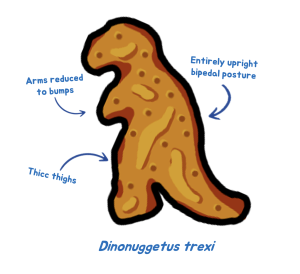
The most commonly pictured Turkey Dinosaurs are the Tyrannosaur morph. This species appears at first to be similar to the Cretaceous era theropod dinosaur, Tyrannosaurus rex. However, there are a number of differences.
The clearest difference is in the animal’s posture. D. trexi stands bipedally almost like a human, its backbone attaching at the base of the skull and running more or less straight down. The animal props its tail on the ground to support this posture in a similar way to a Kangaroo.
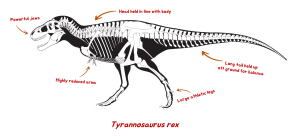
T. rex by contrast stands more horizontally, holding its head out aligned with the backbone, rather than awkwardly at 90 degrees to it. This allows the animal to be a much more efficient hunter, with the tail held out for balance instead of dragging painfully along the ground.
This likely goes a long way to explaining why T. rex was an apex predator at the top of the food chain, whilst D. trexi has zero natural defences against being smothered in ketchup and eaten by children.
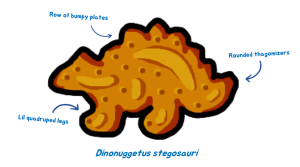
Much like its bipedal relative, D. stegosauri holds some striking resemblances to a non-avian dinosaur, Stegosaurus.
Both have rows of plates along their backs, though their functions differ. In Stegosaurus, the exact use of the plates isn’t known for certain, but likely theories indicate that they could be for display.
The plates are covered in traces of blood vessels, indicating they supported living tissue on the bone. This tissue may have been brightly coloured, used for attracting mates or intimidating predators. It has even been suggested that some stegosaurs show a degree of sexual dimorphism in the shape and size of these plates.
Another oft quoted theory is that Stegosaurus may have used these plates for thermoregulation, pumping blood into them to cool down or be used for heating like solar panels.
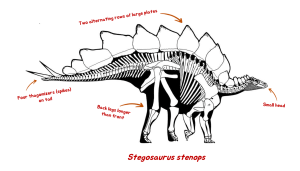
If D. stegosauri had evolved these plates for thermoregulation, they seem to do a spectacularly poor job. Studies show that during their lifetimes, the internal body temperature of Dinonuggetus varies by an astonishing 90oc, from literally frozen to roasting hot. This is far from the ideal staple of homeostasis most animals strive for.
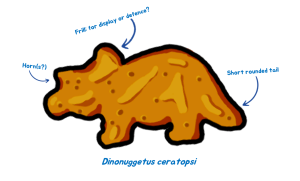
The final species variant is another quadruped, D. ceratopsi, once again named for the prehistoric reptile it mimics.
Many of the ceratopsian dinosaurs, like the famous Triceratops, possess large facial horns that can be used in competition for mates. Despite often being shown as squaring off against a large carnivore, the primary use of these horns would have been against others of the same species.
The positioning of the two large horns above the eye would have allowed the animals to effectively lock together in a competition of strength. Numerous Triceratops specimens show evidence of this brutal fighting etched into their skulls, such as gouge marks across their frills caused by the glancing blows of horns.
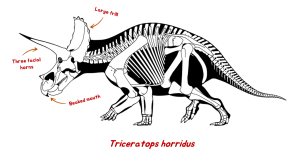
It is difficult to tell exactly how many horns D. ceratopsi possessed or how it might have used them, due to the animal being almost entirely two-dimensional.
Convergence
In 2021 there was a sudden increase in the diversity of Turkey Dinosaurs in the dinner ecosystem. However, genetic analysis revealed something remarkable. The new morphs were actually part of a completely new genus; Veganuggetus.
A very important principle in palaeontology is convergent evolution. This happens when completely different groups of animals evolve remarkably similar features to combat the same environmental challenges.
A common example is the streamlined body shape evolved by sharks and ichthyosaurs. Their bodies look remarkably similar, despite one being a chondrichthyan and the other being a reptile.
And so, nearly 30 years after Turkey nuggets evolved on this path, Quorn nuggets were seen to evolve a dinosaurian body plan (Turkey dinosaurs of course being that rare example of a creature in nature that evolves not to become more efficient at eating food, but instead to become more efficient at being eaten).
Remarkably, this convergence took place despite the two groups not even being part of the same kingdom of life. Tissue sample studies prove that Dinonuggetus are within animalia, whereas Veganuggetus fall within the fungi. This makes the fact that they taste identical even more astounding.
What drove this sudden diversification event? Unlike most animal evolution, driven by changes in climate, habitat, sexual selection, or availability of food, the Quorn Diversification of 2021 was driven entirely as a result of a single event, namely a drunken message to a major corporation by an Irish woman. This is the first and only known case of a DM slide resulting in a major ecological transition.

Two of the newer organisms look remarkably similar to the well-known species, and have been named accordingly; Veganuggetus trexi and V. stegosauri. But, a remarkable new species also appeared at this time.
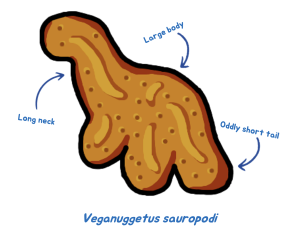
There is a misconception that Dinonuggestus had a long-necked species, reminiscent of the giant sauropod dinosaurs. However, no such creature had ever existed. It’s a palaeo-snack example of the famed Mandela Effect. However, Veganuggetus does have a such a morphotype, V. sauropodi.
The long necks of sauropod dinosaurs are used to effectively feed on vegetation few other animals can reach. The purpose of the long neck in V. sauropodi is totally unknown. No species of nugget-dinosaur has a functioning digestive system or even mouth, so it would have no need to evolve any specialised feeding mechanism.
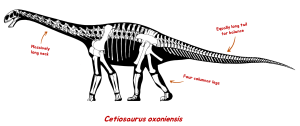
Being so large meant sauropod dinosaurs required large amounts of food to survive, raising questions of how any environment could sustain multiple species together, something the fossil record shows did happen. Analysis of their teeth and skulls show that the sauropods evolved ‘niche partitioning’, meaning they specialised in eating different kinds of foliage, avoiding direct competition with each other and allowing for peaceful co-existence. V. sauropodi are not seen to partake in any niche partitioning, as all of them share the exact same tooth morphology. None.
Conclusions
Though all species of Dinonuggetus and Veganuggetus are seen to be extremely poorly adapted for survival, somehow they continue to thrive in the modern ecosystem. This is likely due to them being what scientists call ‘a bit moreish’. Interestingly they are regularly found in mixed-species herds, a behaviour that fossilised trackways suggest may also have occurred in herbivorous dinosaurs too.
Their resemblance to creatures that died 66 million years ago continues to rightly fascinate children and millennials alike. Time will tell if new morphs will emerge in time, and what branches of life they may mimic. After all, dinosaurs existed for over 160 million years, and we currently know of over 700 species. Who’s to say we won’t end up with nugget forms of them all?
Join us next time for a deep dive into Potato Smileys. Why are they so happy?
About The Author
Rhys Charles has been the lead of the Bristol Dinosaur Project since 2016. He promises that the BDP Blog will return to more fully scientific content in the next post, though he hopes you enjoyed the sprinkling of facts placed in this entry. You can find info on his other publications here.

